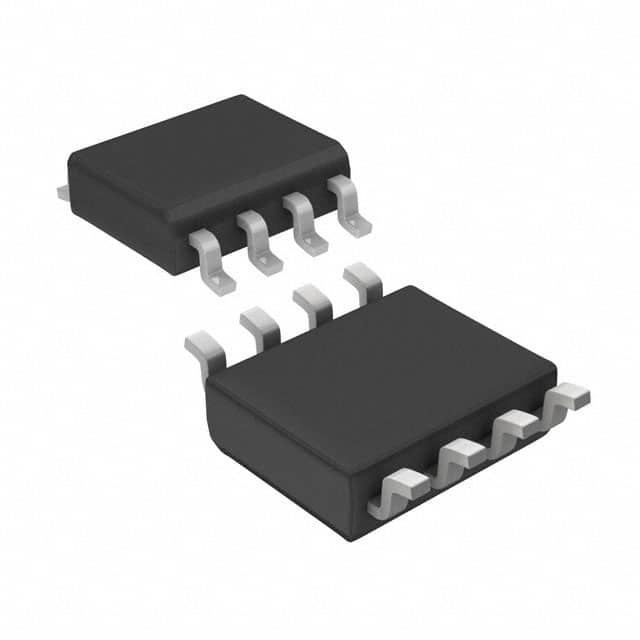Lihat spesifikasi untuk detail produk.

M93C66-MN6T
Product Overview
- Category: Integrated Circuit (IC)
- Use: Non-volatile Memory
- Characteristics: Small form factor, high storage capacity, low power consumption
- Package: SOP-8 (Small Outline Package)
- Essence: EEPROM (Electrically Erasable Programmable Read-Only Memory)
- Packaging/Quantity: Tape and Reel, 2500 units per reel
Specifications
- Memory Size: 4Kbits (512 x 8 bits)
- Supply Voltage: 1.8V to 5.5V
- Operating Temperature Range: -40°C to +85°C
- Write Time: 5ms (typical)
- Data Retention: 200 years (minimum)
Detailed Pin Configuration
The M93C66-MN6T IC has a total of 8 pins arranged as follows:
┌───┬───┐
│ 1 │ 8 │
│ │ │
│ │ │
│ │ │
│ │ │
│ │ │
│ │ │
│ 2 │ 7 │
└───┴───┘
Pin Description: 1. Chip Select (/CS): Active low input used to enable the device. 2. Serial Clock (SCK): Input for synchronizing data transfer. 3. Data Input (DI): Input for serial data. 4. Ground (GND): Reference ground for the IC. 5. Data Output (DO): Output for serial data. 6. Write Protect (/WP): Active low input used to protect memory write operations. 7. VCC: Supply voltage input. 8. Chip Enable (/CE): Active low input used to enable the device.
Functional Features
- Non-volatile memory: Retains data even when power is removed.
- High storage capacity: 4Kbits of memory for storing various data.
- Low power consumption: Operates efficiently with a wide supply voltage range.
- Fast write time: Data can be written in just 5ms.
- Long data retention: Ensures data integrity for up to 200 years.
Advantages and Disadvantages
Advantages: - Compact size allows for easy integration into various electronic devices. - Wide operating temperature range makes it suitable for harsh environments. - Low power consumption prolongs battery life in portable devices.
Disadvantages: - Limited storage capacity compared to larger EEPROMs. - Requires external components for proper operation. - Relatively slower write time compared to some other memory technologies.
Working Principles
The M93C66-MN6T is an EEPROM, which means it uses electrical signals to erase and program data. It utilizes a floating gate transistor structure that can trap or release electrons, representing binary states (0 or 1). The stored data remains intact even when power is removed.
To read data from the memory, the chip select pin (/CS) is activated, followed by providing a clock signal (SCK) and reading the serial data output (DO). Writing data involves activating the chip select pin, providing clock pulses, and sending the desired data through the data input (DI) pin.
Detailed Application Field Plans
The M93C66-MN6T is widely used in various applications, including but not limited to:
- Automotive electronics: Used for storing vehicle configuration data, mileage information, and security-related parameters.
- Consumer electronics: Integrated into smart TVs, set-top boxes, and audio systems for storing user preferences and settings.
- Industrial automation: Utilized in programmable logic controllers (PLCs) for storing program code and configuration data.
- Medical devices: Incorporated into medical equipment for storing patient data, calibration settings, and device parameters.
- IoT devices: Integrated into smart home devices, wearables, and sensors for storing configuration data and firmware updates.
Detailed and Complete Alternative Models
- M93C46-MN6T: 2Kbit EEPROM with similar specifications but lower storage capacity.
- M93C86-MN6T: 16Kbit EEPROM with higher storage capacity but slightly larger package size.
- M93C76-MN6T: 8Kbit EEPROM with intermediate storage capacity and similar characteristics.
These alternative models provide options based on specific memory requirements and form factor constraints.
Word count: 536 words
Sebutkan 10 pertanyaan dan jawaban umum terkait penerapan M93C66-MN6T dalam solusi teknis
Sure! Here are 10 common questions and answers related to the application of M93C66-MN6T in technical solutions:
Q: What is M93C66-MN6T? A: M93C66-MN6T is a serial EEPROM (Electrically Erasable Programmable Read-Only Memory) chip manufactured by STMicroelectronics.
Q: What is the storage capacity of M93C66-MN6T? A: M93C66-MN6T has a storage capacity of 4 kilobits (512 bytes).
Q: What is the operating voltage range for M93C66-MN6T? A: The operating voltage range for M93C66-MN6T is typically between 1.8V and 5.5V.
Q: How is M93C66-MN6T interfaced with microcontrollers or other devices? A: M93C66-MN6T uses a simple 3-wire SPI (Serial Peripheral Interface) protocol for communication with microcontrollers or other devices.
Q: Can M93C66-MN6T be used for storing program code? A: No, M93C66-MN6T is primarily designed for storing small amounts of non-volatile data such as configuration settings or calibration data.
Q: What is the maximum operating frequency of M93C66-MN6T? A: The maximum operating frequency of M93C66-MN6T is typically 5 MHz.
Q: Does M93C66-MN6T support write protection? A: Yes, M93C66-MN6T provides hardware write protection by using a dedicated pin (WP) that can be tied to VCC or GND to enable or disable write operations.
Q: Can M93C66-MN6T withstand high temperatures? A: Yes, M93C66-MN6T is designed to operate reliably in a wide temperature range, typically from -40°C to +125°C.
Q: Is M93C66-MN6T compatible with other EEPROM chips? A: Yes, M93C66-MN6T follows the industry-standard 3-wire SPI protocol, making it compatible with other EEPROM chips that support the same interface.
Q: Are there any specific application examples for M93C66-MN6T? A: M93C66-MN6T can be used in various applications such as automotive electronics, industrial control systems, consumer electronics, and medical devices for storing small amounts of critical data.
Please note that the answers provided here are general and may vary depending on the specific implementation and requirements of your technical solution.

